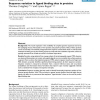258 search results - page 23 / 52 » A Framework for Improving Protein Structure Predictions by T... |
GECCO
2007
Springer
14 years 2 months ago
2007
Springer
In this paper, a model based on genetic algorithms for protein folding prediction is proposed. The most important features of the proposed approach are: i) Heuristic secondary str...
ISMB
2000
13 years 10 months ago
2000
Knowing the number of residue contacts in a protein is crucial for deriving constraints useful in modeling protein folding, protein structure, and/or scoring remote homology searc...
EVOW
2010
Springer
13 years 12 months ago
2010
Springer
A challenging problem in bioinformatics is the detection of residues that account for protein function specificity, not only in order to gain deeper insight in the nature of functi...
ICASSP
2007
IEEE
14 years 3 months ago
2007
IEEE
Protein structure prediction aims to determine the three-dimensional structure of proteins form their amino acid sequences. When a protein does not have similarity (homology) to a...
BMCBI
2005
13 years 8 months ago
2005
Background: The recent explosion in the availability of complete genome sequences has led to the cataloging of tens of thousands of new proteins and putative proteins. Many of the...

